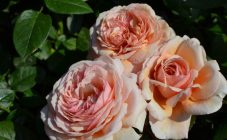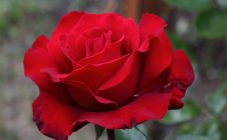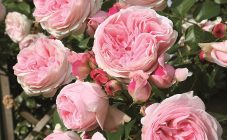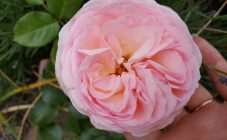Content:
The name of the group of roses "hybrid tea" comes from the ancient tea roses. Then they had the scent of fresh tea and the flowers were beautifully shaped. But they did not tolerate changes in weather conditions, and diseases overcame them quite often. After many years of work of breeders, it turned out to bring out hybrid tea varieties that can withstand cold weather and have received greater resistance to plant ailments. The Kerio variety is the most common among the rose bushes of this group grown in the garden. There is a huge number of beautiful shades, and sweet enchanting aromas, and various shapes of buds. The hybrid tea rose has fairly large flowers, a lush bush that can be medium to large in size.
The history of the creation of the variety
This variety was born by breeders from Holland in 2002. The Dutch organization Lex +, quite well-known in the world of gardeners, from the first days of its formation, strived to create unique species of roses, in which flowers of high quality, easily tolerate cold and are resistant to diseases. The scientists of this particular company developed the Kerio hybrid tea rose.
After the Kerio rose was officially registered, it began to gain popularity not only in the Netherlands, but all over the world. Saplings spread in many countries, including Russia. Today, the shrub of this variety can be seen not only in state greenhouses, but also in private gardens of amateur flower growers.
Description rose Kerio
Kerio bushes, due to their main characteristics, are recognized as one of the best hybrid roses that are grown for cutting. The yellow Kerio rose is found in almost all flower shops. All this is due to its attractiveness and long-term preservation in cut form.
Rose Kerio has erect, tall and rather lush bushes up to 0.6 m in diameter. Straight stems can be up to 1.2 m long, and they are quite strong. Relatively few thorns grow on the shoots, so there will be no difficulties in caring for the bush: the grower will not be scratched.
When the flower is cut, it can last for at least 2 weeks, which is why Kerio roses are popular with florists around the world.
Such hybrids bloom in the form of single flowers, but sometimes they can be found in inflorescences and 4 pieces each, due to which there is a feeling of a full-fledged lush bouquet. Flowering occurs repeatedly, but it is frequent and prolonged.
Landing
If a florist decides to plant a Kerio rose in spring or autumn, it is better to pay attention to seedlings whose root system is closed and the part of the root above the ground is well developed. It is necessary to plant a flower in places where the soil is fertile and air circulates well in it. The soil should be well lit by the sun and be free of drafts.
How to land:
- It is better to buy material for planting in the spring: in the last days of March or the first days of April.
- In advance, you need to prepare holes for planting, their depth should be about 50 cm, but if the root system is long, then it is worth digging a hole deeper.
- Before planting in a permanent place, the seedlings should lie down for several days in a cool place, for example, a cellar or refrigerator.
- Planting the plant must be done in a wet pit, which contains a mixture of nutrients (humus, sand and peat in a 1: 1: 1 ratio).
- When immersing the root system in a hole, you need to carefully monitor the condition and location of the bark neck, since it should be level with the ground.
- After the plant is planted, it should be watered abundantly and shaded for 2 weeks.
Further care
After landing Kerio will have a long and painstaking care. If everything is done correctly, then the rose will thank with abundant flowering:
Fertilizer
You need to feed the bushes 2 times a year just before the flowering periods. Usually, the first time is in April, and the second is at the end of July.
When growing a Kerio rose, you need to pay special attention to the introduction of mineral and organic fertilizers. The first nitrogen fertilization is best done in the spring. You can use humus. With its help, the bush will be able to find rich greenery, and the foliage will become brighter.
Before the bush begins to bloom, fertilize with potassium and phosphorus should be applied.
Watering
Water the ground as soon as a dry crust forms on it, because the rose does not like it when a lot of water stagnates in its soil. It is recommended to water the bush with warm water, it is desirable that it be settled. If watering is carried out from a hose, it is recommended to carefully monitor: do not pour over the bushes and do not pour on the foliage. Water on the leaves and buds can cause sunburn. Therefore, watering is best done late in the evening.
Pruning
This procedure is one of the most important in the care of climbing roses. It is carried out for the purpose of sanitization (dry, damaged shoots are removed), as well as to improve the appearance of the plant. Pruning should be carried out with a sharp tool, the distance from the bud should be about 0.5 cm.If pruning is carried out with not sharpened pruners or scissors, the direction of growth of the shoot can change significantly, which will further lead to a violation in flowering.
Cropping value:
- Clarification of the crown of the plant. Shoots should be cut towards the outer bud. If you cut in the opposite direction, the crown will become thicker because the shoots will grow inward.
- Elimination of dead shoots... Every year, more and more new shoots grow at the root system, they become the highest priority, which means that less nutrients are supplied to the old branches, and therefore they die off over time. They need to be removed so that the young do not have competition in nutrition, and the old dead ones do not start to rot and spread various diseases.
Pests and diseases
If you take care of the Kerio rose according to all the rules and devote enough time to it, practically no diseases will be able to affect it. The rose is not susceptible to powdery mildew, which often attacks other varieties of roses, and rust. The bush can resist fungal infections and root decay. All of these problems can be a consequence of the unfavorable conditions in which the plant is found.
The bush can sometimes be attacked by harmful insects, for example, rose aphids, spider mites, nematodes and thrips. If the gardener takes the necessary preventive measures in time, the parasites will not harm, but will bypass the flower garden. To do this, you need to use special insecticides, which can be purchased at a gardening store.
Advantages and disadvantages of the variety
Pluses of Kerio rose:
- tolerates harsh climate conditions;
- has a wonderful delicate aroma;
- has a long flowering period;
- bushes can take various forms with and without pruning;
- famous for its resistance to insects and diseases;
- a cut flower can last more than 2 weeks.
Cons of this variety:
- hypersensitivity to organic fertilizers, so you should watch out so as not to overfeed;
- weakness in front of flower beetles.
As flower growers managed to notice, the bush has only 2 minuses, but they are also fixable. If you properly care for the roses and take timely preventive measures against pests, Kerio will be able to delight you with its bright yellow flowers for many years.
















